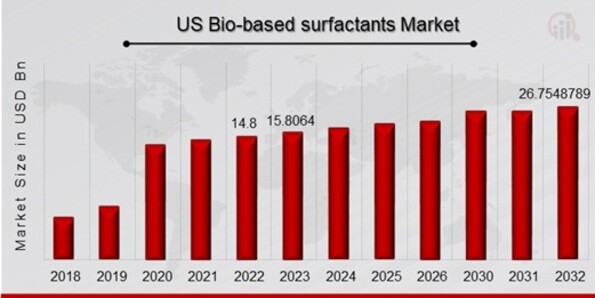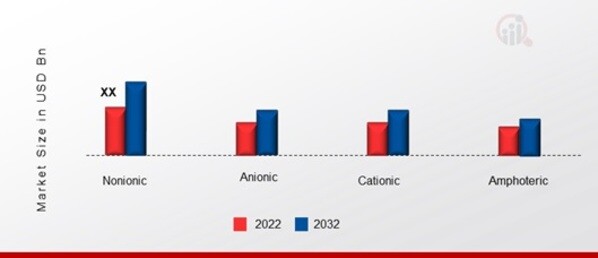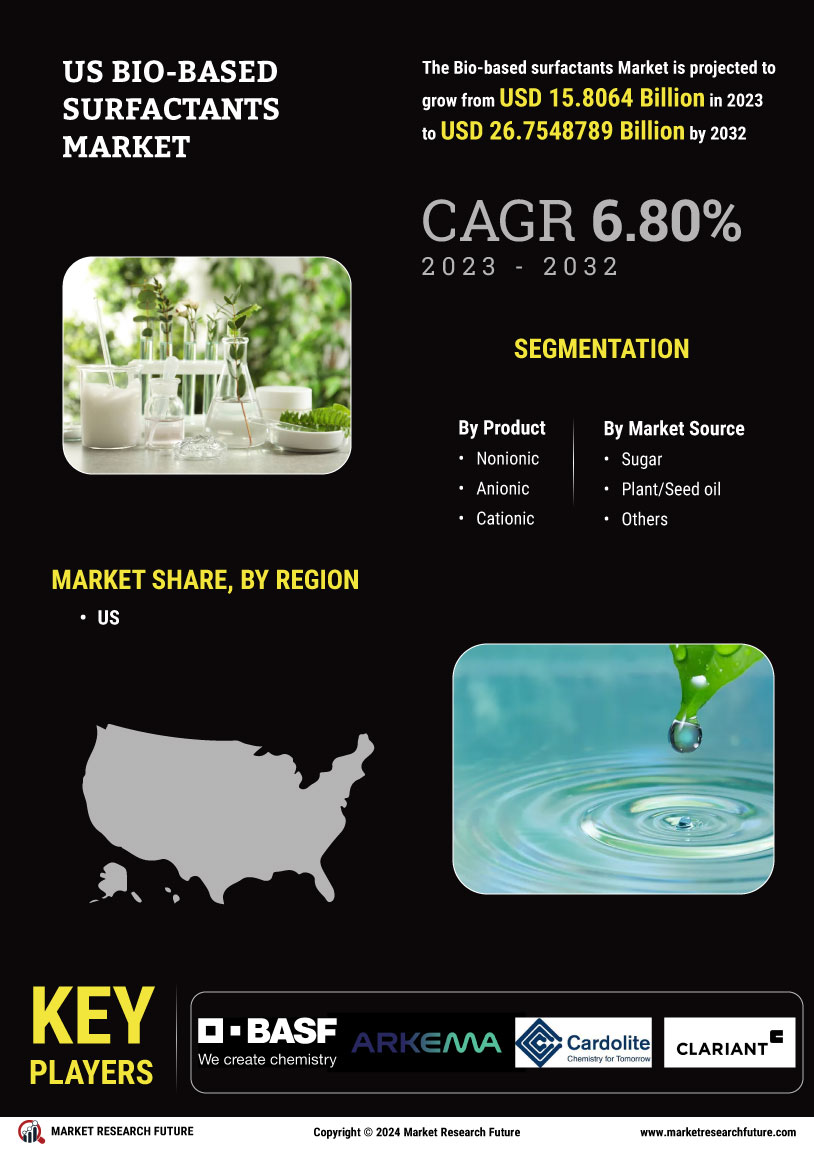US Bio-based surfactants Market Overview
US Bio-based surfactants Market Size was valued at USD 14.8 Billion in 2022. The Bio-based surfactants Market is projected to grow from USD 15.8064 Billion in 2023 to USD 26.7548789 Billion by 2032, exhibiting a compound annual growth rate (CAGR) of 6.80% during the forecast period (2023 - 2032). Increasing adoption of bio-based surfactants, consumer goods, and personal care industry, and the expansion of the cleaning and detergents industry are the main market drivers anticipated to propel the Bio-based surfactants Market in the US.

Source: Secondary Research, Primary Research, MRFR Database and Analyst Review
Bio-based surfactants Market Trends
-
Increasing demand for the cleaning and detergents industry is driving the market growth
The market for surfactants is experiencing robust growth, propelled by an increasing demand within the cleaning and detergents industry in various regions, including the United States. Surfactants, particularly Anionic types, play a pivotal role in this sector due to their exceptional cleaning and foaming properties. As consumers place greater emphasis on cleanliness and hygiene, there is a heightened need for effective cleaning formulations in household products, dishwashing liquids, and laundry detergents. The versatility of surfactants in emulsifying and dispersing oils and soils makes them indispensable for achieving optimal cleaning performance. Furthermore, as sustainability gains prominence, the industry is witnessing a shift towards eco-friendly and biodegradable surfactants. This confluence of factors, including consumer preferences for efficient cleaning solutions and the industry's responsiveness to environmental concerns, positions the surfactant market at the forefront of driving innovation and meeting the evolving demands of the cleaning and detergent industry.
Furthermore, the US’s growing awareness of consumer goods and personal care industry, industrial applications, and expansion of health and hygiene products are driving up demand for the market. The United States is experiencing a notable surge in demand for surfactants, driven by an increasing awareness of diverse applications across key sectors. The consumer goods and personal care industry is witnessing a growing consciousness among consumers, fostering a demand for milder formulations in products like shampoos and skincare items. Simultaneously, industrial applications, where surfactants, particularly versatile Amphoteric types, play a crucial role in processes such as metal cleaning and textiles, are contributing significantly to market growth. Additionally, the expansion of health and hygiene products, leveraging the antimicrobial properties of Cationic surfactants, aligns with the heightened focus on public health. This confluence of factors highlights the adaptability and versatility of surfactants, making them integral to the formulation of products spanning various industries.
Bio-based surfactants Market Segment Insights
Bio-based surfactants Market Product Insights
The US Bio-based surfactants Market segmentation, based on Product includes Nonionic, Anionic, Cationic, and Amphoteric. The nonionic segment dominated the market mostly. Nonionic surfactants, characterized by their lack of charge in the hydrophilic head, offer a range of beneficial properties that contribute to their widespread use across various applications. One key factor driving the dominance of the nonionic segment is its versatility. Nonionic surfactants are known for being mild and less prone to irritating, making them well-suited for formulations in the consumer goods and personal care industry.
Figure 1: US Bio-based surfactants Market, by Product, 2022 & 2032 (USD Billion)

Source: Secondary Research, Primary Research, MRFR Database and Analyst Review
Bio-based surfactants Market Source Insights
The US Bio-based surfactants Market segmentation, based on Source, includes Sugar, Plant/Seed oil, and Others. The sugar category generated the most income. Sugar-based surfactants, often derived from sources like glucose or sucrose, are part of the broader category of bio-based surfactants. These surfactants can be considered more environmentally friendly compared to their petroleum-based counterparts. They are renewable, biodegradable, and may offer certain performance benefits.
Bio-based surfactants Market Country Insights
The bio-based surfactants market is experiencing noteworthy growth globally, driven by a collective push towards sustainability and environmental responsibility. Several countries are actively contributing to the expansion of this market, recognizing the significance of renewable and biodegradable alternatives in various applications. In the United States, for example, increasing consumer awareness of eco-friendly products has spurred demand for bio-based surfactants in the consumer goods, personal care, and industrial sectors. European countries, with their stringent environmental regulations, are also playing a pivotal role in fostering the growth of the bio-based surfactants market. Additionally, countries in Asia, particularly those with a strong focus on sustainable practices, are witnessing a surge in the adoption of bio-based surfactants across diverse industries. This global trend reflects a collective commitment to reducing the environmental impact of chemical formulations, positioning bio-based surfactants as key contributors to sustainable and responsible business practices on an international scale.
Bio-based surfactants Market Key Market Players & Competitive Insights
Leading market players are investing heavily in research and development in order to expand their product lines, which will help the Bio-based surfactants Market grow even more. Market participants are also undertaking a variety of strategic activities to expand their footprint, with important market developments including new Product launches, contractual agreements, mergers and acquisitions, higher investments, and collaboration with other organizations. To expand and survive in a more competitive and rising market climate, Bio-based surfactants Market Products must offer cost-effective items.
Major players in the Bio-based surfactants Market are attempting to increase market demand by investing in research and development operations, including BASF, Arkema, Cardolite, Clariant, Croda, Dow, Fenchem, Galaxy, Surfactant, Henkel.
Key Companies in the Bio-based surfactants Market include
- BASF
- Arkema
- Cardolite
- Clariant
- Croda
- Dow
- Fenchem
- Galaxy
- Surfactant
- Henkel
Bio-based surfactants Market Product Developments
October 2023: Pilot Chemical Company announced the launch of CalCare™ 190C, a sustainable biosurfactant designed specifically for the personal care industry. The key attributes of CalCare™ 190C include a 98.6% Renewable Carbon Index, clear color, stable pH Range (3 to 11), and the ability to form a high and stable foam.
December 2023: Clariant, a sustainability-focused specialty chemical company, today announced its decision to shut down its sunliquid® bioethanol production in Podari, Romania, and to downsize related activities of the business line Biofuels & Derivatives in Germany (Straubing, Planegg and Munich).
Bio-based surfactants Market Segmentation
Bio-based surfactants Market Product Outlook
- Nonionic
- Anionic
- Cationic
- Amphoteric
Bio-based surfactants Market Source Outlook
- Sugar
- Plant/Seed oil
- Others
| Report Attribute/Metric |
Details |
| Market Size 2022 |
USD 14.8 Billion |
| Market Size 2023 |
USD 15.8064 Billion |
| Market Size 2032 |
USD 26.7548789 Billion |
| Compound Annual Growth Rate (CAGR) |
6.80% (2023-2032) |
| Base Year |
2022 |
| Market Forecast Period |
2023-2032 |
| Historical Data |
2018- 2022 |
| Market Forecast Units |
Value (USD Billion) |
| Report Coverage |
Revenue Forecast, Market Competitive Landscape, Growth Factors, and Trends |
| Segments Covered |
Product, Source, Purpose, Organization and Region |
| Countries Covered |
South East Asia and India |
| Key Companies Profiled |
BASF, Arkema, Cardolite, Clariant, Croda, Dow, Fenchem, Galaxy, Surfactant, Henkel. |
| Key Market Opportunities |
· Expanding Use in Industrial Processes. · Growing Demand for Sustainable Products. |
| Key Market Dynamics |
· Increasing Demand Consumer Goods and Personal Care Industry · Health and Hygiene Products |
US Bio-based surfactants Market Highlights:
Frequently Asked Questions (FAQ) :
The US Bio-based surfactants Market size was valued at USD 14.8 Billion in 2022.
The market is projected to grow at a CAGR of 6.80% during the forecast period, 2023-2032.
The key players in the market are BASF, Arkema, Cardolite, Clariant, Croda, Dow, Fenchem, Galaxy, Surfactant, Henkel, Ter Chemicals, Pilot Chemical Company, Evonik, Glycosurf, Solvay.
The nonionic category dominated the market in 2022.
The sugar category had the largest share in the market.




























